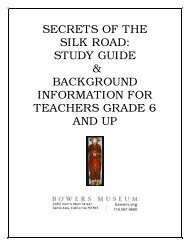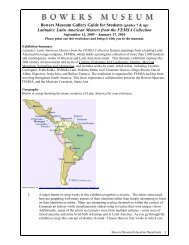A Resource Guide for Students and Teachers - Bowers Museum
A Resource Guide for Students and Teachers - Bowers Museum
A Resource Guide for Students and Teachers - Bowers Museum
You also want an ePaper? Increase the reach of your titles
YUMPU automatically turns print PDFs into web optimized ePapers that Google loves.
Glossary<br />
Bi – a disc <strong>for</strong>m usually made of<br />
jade, from the Neolithic period<br />
onwards as a ritual object used in<br />
burials. The significance of the<br />
<strong>for</strong>m is not entirely clear, though<br />
its round <strong>for</strong>m may symbolize<br />
heaven.<br />
Buddhism – a religion based on<br />
the teachings of the Buddha, the<br />
“Enlightened One,” who lived in<br />
northern India in the 6th century<br />
BC. He taught that suffering is<br />
caused by attachment or clinging,<br />
<strong>and</strong> advocated living a life of<br />
moderation, non-attachment <strong>and</strong><br />
compassion.<br />
Calligraphy – literally, “beautiful<br />
writing,” one of the most<br />
respected art <strong>for</strong>ms in China.<br />
Chinese characters are written<br />
with a brush <strong>and</strong> ink on paper<br />
or silk in a number of different<br />
styles.<br />
Celadon – a high-firing, greenish<br />
glaze that derives its color from<br />
tiny quantities of iron oxide<br />
that turn the glaze green in an<br />
oxygen-starved kiln atmosphere.<br />
Confucianism – a philosophy<br />
based on the teachings of<br />
Confucius, who lived in China<br />
in the 6th century BC. He taught<br />
the importance of relationships,<br />
particularly between ruler <strong>and</strong><br />
subject <strong>and</strong> parent <strong>and</strong> child, <strong>and</strong><br />
the need <strong>for</strong> benevolence on the<br />
part of the ruler <strong>and</strong> parent, <strong>and</strong><br />
respect on the part of the subject<br />
<strong>and</strong> child.<br />
Cong – a cylinder with a square<br />
cross-section made of jade <strong>and</strong><br />
used in burials. The significance<br />
of the <strong>for</strong>m is not entirely clear,<br />
though its <strong>for</strong>m may represent<br />
heaven (round) <strong>and</strong> earth<br />
(square).<br />
Daoism (pronounced Dow-ism, also<br />
spelled Taoism) – an ancient<br />
Chinese philosophy based on the<br />
concept of the Dao, or “Way,” a<br />
<strong>for</strong>ce that animates the universe<br />
<strong>and</strong> inhabits all things. The<br />
philosopher Laozi, who lived in<br />
the 6th century BCE, is believed<br />
to have written the Daode jing, a<br />
text which taught the importance<br />
of living in harmony with the<br />
Dao.<br />
Ding – ancient tripod vessel used in<br />
burials to contain wine <strong>for</strong> the<br />
deceased.<br />
Divination – the art of predicting<br />
future events using supernatural<br />
powers.<br />
Dynasty – a succession of rulers<br />
who belong to the same family<br />
<strong>and</strong> rule over generations.<br />
Earthenware – a low firing clay<br />
(up to 1,000°C) resulting in<br />
porous, less durable ceramics<br />
such as roof tiles, flower pots, etc.<br />
Usually unglazed.<br />
Glaze – a glassy coating added<br />
to ceramics <strong>for</strong> protection <strong>and</strong><br />
decoration.<br />
Han Chinese – an ethnic<br />
group originating in China<br />
<strong>and</strong> constituting 92% of the<br />
population of China, a total of<br />
about 1.3 billion people.<br />
Huaniao – literally, “bird <strong>and</strong><br />
flower,” traditional Chinese<br />
paintings of birds, flowers, insects<br />
<strong>and</strong> other details of nature.<br />
Jingdezhen – a city in Jiangxi<br />
province in southern China that<br />
has produced the bulk of China’s<br />
porcelain since the 11th century<br />
AD.<br />
Lacquer – a coating made from<br />
the sap of the lacquer tree (Rhus<br />
verniciflua), which is applied to<br />
objects to make them resistant<br />
to water, heat, acid <strong>and</strong> insects.<br />
It is often colored – <strong>for</strong> example,<br />
black, red <strong>and</strong> green – <strong>and</strong><br />
decorated with painted, carved or<br />
inlaid designs.<br />
Manchus – a northern nomadic<br />
people from Manchuria, who<br />
conquered the Han Chinese <strong>and</strong><br />
established the Qing dynasty in<br />
1644. They considered themselves<br />
descendants of the Mongols.<br />
Mongols – a nomadic people who<br />
originated in the Central Asian<br />
plateau, north of the Gobi desert<br />
<strong>and</strong> south of Siberia, in what is<br />
now Mongolia, China <strong>and</strong> Russia.<br />
Under the leadership of Genghis<br />
Khan (c.1160–1227), the Mongols<br />
created the second largest empire<br />
in world history, extending from<br />
Manchuria in the east to Hundary<br />
in the west. They ruled China<br />
under the Yuan dynasty (1279-<br />
1368).<br />
Nomadic – a lifestyle that involves<br />
moving from place to place,<br />
usually according to the seasons,<br />
in search of food <strong>and</strong> water<br />
<strong>for</strong> oneself <strong>and</strong> one’s herds of<br />
animals.<br />
Neolithic Period – literally,<br />
“New Stone Age,” the period<br />
of transition from a nomadic,<br />
hunting existence to a more<br />
settled, agricultural lifestyle.<br />
Oracle Bones – Animal bones<br />
<strong>and</strong> shells used in divination.<br />
Questions were written on them<br />
in China’s earliest <strong>for</strong>m of writing<br />
<strong>and</strong> heat was applied to create<br />
cracks which were believed to<br />
provide answers to the questions.<br />
Pictograph – literally “writing with<br />
pictures,” ancient script made<br />
up of pictures that evolved into a<br />
written language.<br />
Porcelain – a high-firing clay<br />
(c.1300°C) resulting in a pure<br />
white, translucent, ringing, nonporous,<br />
highly durable ceramic,<br />
usually glazed <strong>and</strong> decorated with<br />
31





